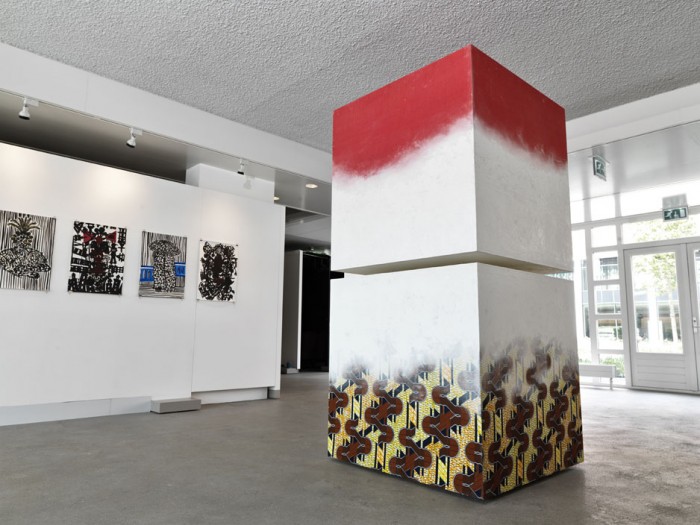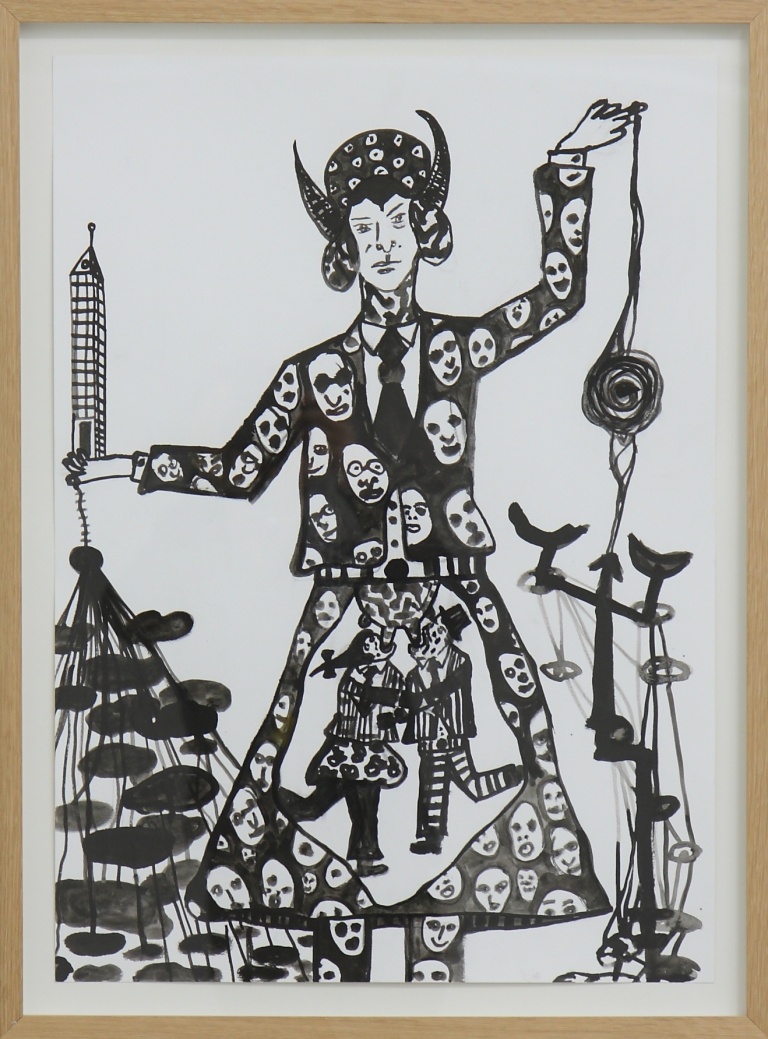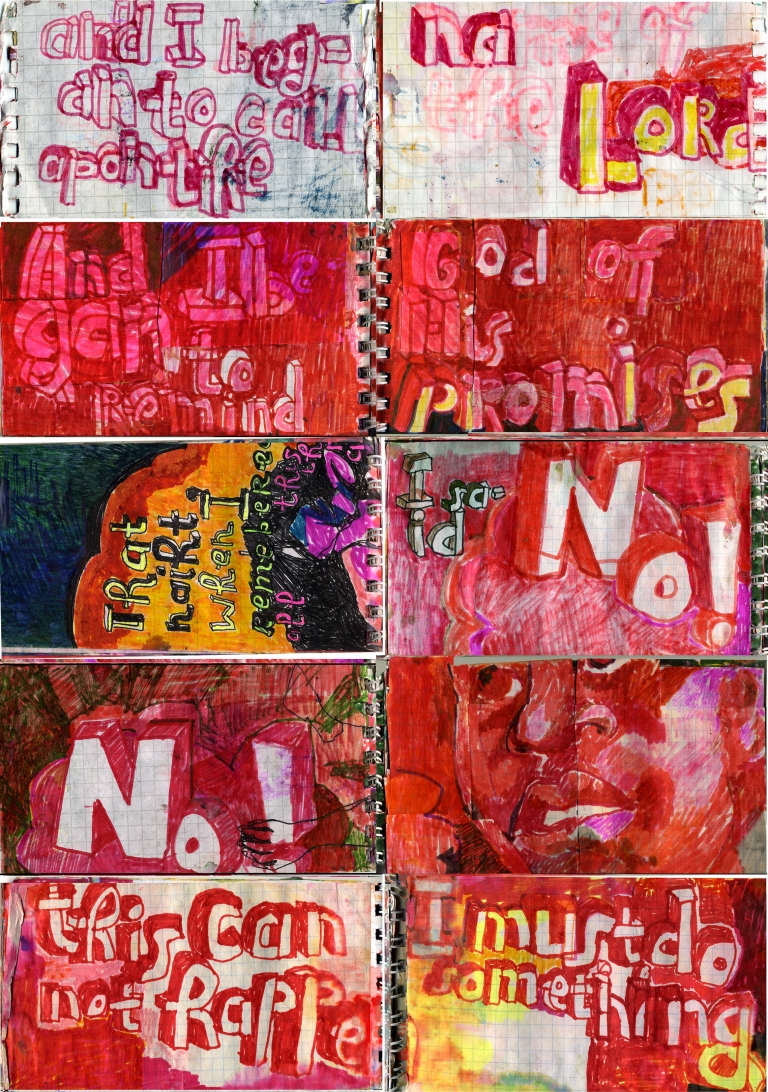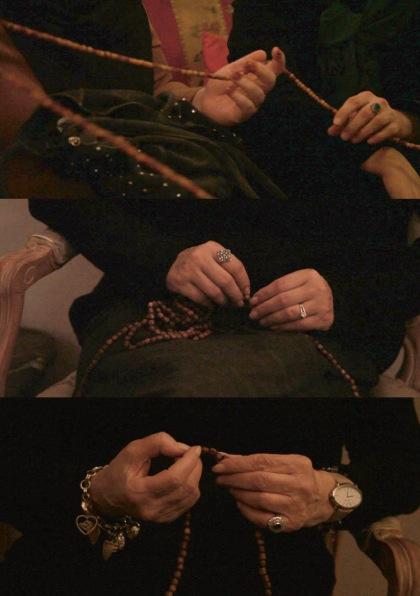About the exhibition ‘Inspired’ in the CBK Zuidoost (also on Facebook)
Inspiration has various faces
During exhibitions I often ask myself to what extent the location or the surroundings influence my perception. ‘Inspired‘ is an exhibition “about religion, rituals and death”. Presentation of such an exhibition in the Amsterdam Bijlmermeer is in principle very logical. No neighborhood in the city is so saturated with religion as Southeast. Due to the composition of the population – the majority of the residents come from Suriname, the Antilles or from Africa – is religion, whatever religion it is, and the accompanying rituals, an important part of daily life. Other uses are feverishly being sought for churches in the inner-city of Amsterdam in order to be able to retain the buildings, while in the Bijlmer homes and other locations are being sought in order to be able to provide shelter for the many believers. It is unavoidable that the ‘local’ resident experience the exposition ‘inspired’ differently than the average canal-belt resident. As a disbeliever but convinced Bijlmermeerder I have a sometimes confusing in-between position therein.


In the first space ‘Inspired’ immediately sets the tone. A large sculpture from Remy Jungerman (Moengo, 1959) captures full attention. Two cubes, with a small space between them, are placed one on top of the other. They are covered with Vlisco-materials (a Dutch company that could never have existed without slavery and colonialism) and finished thereafter with kaolin, a white, porcelain-like cement material which is found under the bauxite in the Surinamese interior (Moengo), (just as the materials) is used during winti rituals and today still under the appropriate brand name Power Pemba being traded by the Moengo Minerals company. Jungerman has succeeded in implicitly mixing the theme into a sculpture which makes an impression even without those connotations.

Jungerman’s work faces towards a wall with six ‘drawings’ (a reference to the six days in the story of creation) from Hamid El Kanbouhi (Larache, 1976). In his increasingly familiarstyle of rough, mostly black lines and spots, he sketches simple and thus moving scenes which show how cultures (read also: religions) allow themselves to be identified but also to be mixed. Contradictions go hand in hand. His loose style results in a beautiful contrast with Jungerman’s austere work.

It is dangerous to have two home strikes at the start of an exhibition. The other works seem to immediately need to compete with them. That is not always successful. Lena Davidovich (Bobruisk, 1970) tells the unbelievable (!) story of a Nigerian clergyman who gets a second chance after dying in a car accident: ‘Raised from the Death’ (2004). Superstition, religion and rituals have formed a monstrous alliance. The story is a sort of visual diary laid out in an animation and a showcase in which the scenes from the video are explained. The scenes are painted expressionistic, with an effective use of color; the animation has been filmed in a seemingly clumsy manner (William Kentridge has made this style popular) which gives rise to emotions. Because the commentary voice is that of the dead clergyman, the work – intentional or unintentional – gets a comparative tone.

That comparative tone is missing in the work of Curaçao’s Avantia Damberg (Leeuwarden, 1977). She also contributed an animation: – ‘The After Life’ (2014) – and a series of drawings which are apart from the animation. The content of the animation is derived from conversations which Damberg conducted with religious friends. These havebeen converted in a lively, indicative manner into moving scenes, but the added storytelling voice has too much of a messenger’s tone formy taste. She attempts to steer me too much. Art is for open questions, not for steering.

In the filmed performance of Saliou Traoré (Burkina Faso) – ‘I am so surprised’ from 2014 – the artist plays the role of a Christian pastor who attempts to win souls on location in the Bijlmer. Because he has little success and because his presentation can hardly be more cliche-like, the work is seen as a mockery or at least a critical approach to the phenomenon. If that is also the intention . . . ???

The video-installation ‘Tevhid’ (2014) from Koštana Banović (Sarajevo, 1965) is in fact a registration of various mourning rituals spread over three monitors. In this way a composition of scenes emerge which allows the work to rise far above the regular documentary. Unfortunately the work has too little physical space. Bigger projection would have given the work more impact. The presentation is too discreet.

Ida van der Lee’s work – ‘The Remembrance Cabinet’ from 2009 – also has presentation problems. The table and the whole-lot-of spaces-cabinet almost stand in the way. They are both filled with objects that give rise to memories of deceased loved ones. As visitor you may add your own object there. Because the objects are personal and have little emotional or esthetic value for the average viewer, the work gets the character of being an arbitrary display. The work is too private to be able to estimate its value. I was a bit ashamed of my sober approach, but the presentation misses the load which a personal subject as this needs for it to appeal in a universal manner.
‘Inspired’ is an interesting and daring exposition. Such a theme can quickly lead to one on one works – flat translations of the theme – or giving space to misplaced emotions. That did not happen. There is unbalance in the quality: the first space has a higher level than the second. That is not always caused by the work of the artists, but surely also by the lack of space which they have there.
I am curious about what the reaction to this exhibition would have been if it was presented in a gallery somewherein the center of Amsterdam. Lots of Bijlmer residents most likely have more affinity with the theme and are most likely better able to identify the customs and procedures due to their cultural background. On the one hand that fact makes it, as they say, logical that ‘Inspired’ stands in CBK Zuidoost (also on Facebook), while on the other hand that also forms a valid motive and a challenge to stage the exhibition elsewhere.
TEXT Rob Perrée, Amsterdam, May 2014
Rob Perrée is art historian and works as freelance writer, art critic and curator, specialized in contemporary (Afro-) American art, African art, Surinamese art and art using new media. His work has appeared in countless catalogues, books, magazines and newspapers. He is editor of Sranan Art Xposed, editor in chief of Africanah.org and a member of the editing team of Pf Photo Magazine. His website: http://robperree.com.
TRANSLATION David F. Michael
What: ‘Inspired’ [Bezield], seven artists about religion, rituals and death: Koštana Banović, Avantia Damberg, Lena Davidovich, Remy Jungerman, Hamid El Kanbouhi, Ida van der Lee and Saliou Traoré
When: until June 29, 2014. Opening hours: Tuesday, Wednesday & Saturday: 11:00-17:00 hrs, Thursday: 11:00-20:00 hrs, Saturday: 10:00-17:00 hrs, or by appointment
Where: CBK Zuidoost (also on Facebook), Anton de Komplein 120, Amsterdam, the Netherlands
A video (trailer of Posso Entrar [May I Enter]) by Koštana Banović:
A video (trailer of Traffic Mum) by Saliou Traoré:
was has the inspiration done to you?
LikeLike